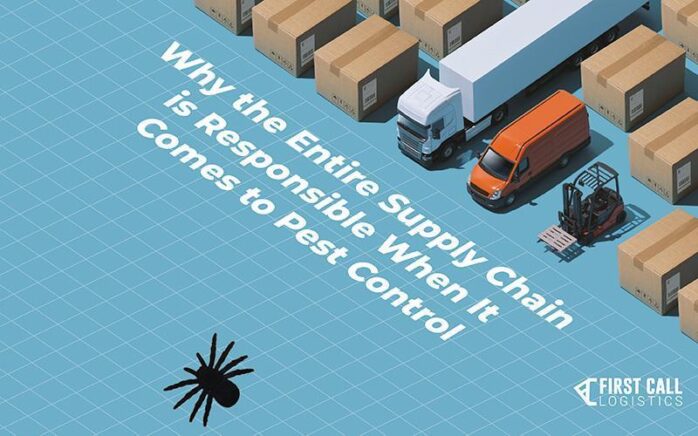Pest Control: Why the Entire Supply Chain Is Responsible

A pest problem in any one element of your company’s supply chain can quickly become everyone’s problem. Your suppliers, their shipments, your facility, and your distributors are all key players in the supply chain — and they are all responsible for doing their part in safeguarding against common pests and the potential dangers they pose to your business.
If pests find a way into your facilities, they can wreak havoc on your bottom line by damaging and contaminating raw materials, not to mention tarnishing your reputation with customers. Here are the most common pest problems faced by shippers and what you should know to keep your facilities clean and pest-free.
Pest Control Is a Concern for Every Business
Damage caused by invasive pests amounts to billions in lost revenue each year. Though invasive pest threats are often a challenge associated with agriculture and food products specifically, pests don’t discriminate when it comes to infiltrating product shipments, storage facilities, trailers, and even your wooden pallets. Keeping your trailers and warehouses pest-free is a job for everyone in the industry, not just those storing and delivering food.
Keeping large facilities pest-free is a constant battle. Following protective best practices and recognizing the early signs of a possible contamination problem can go a long way to avoiding costly infestations and keeping your supply chain operations running smoothly.
Know Thine Enemy: Common Pests Found in Warehouses
It’s important for workers at every stage of the supply process to have at least a basic understanding of common pest threats and how to catch the early signs of an infestation (prevention is generally simpler and a whole lot cheaper than full-blown extermination). Some of the most common warehouse pests include the following:
Rodents
Flies
While more of a threat to food retail than non-food products, flies both large and small are a consistent threat to warehouse storage, particularly through the spring and summer months.
Spiders, Ants, and Cockroaches
These three form the trifecta of pests most everyone can immediately recognize, as they are not unique to warehouses or food retail alone. Identifying the members of this trio is generally a simpler task than the remaining pests on this list, but that doesn’t make them any less problematic.
Common Beetles
Beetles (including the aptly-named warehouse beetle) like to infest dry foods and ingredients, but can sometimes be overlooked for simply not being roaches.
Spider Beetles
Spider beetles are, to put it mildly, pretty gross. These guys can carry E. coli and other bacteria into your food storage, contaminating large shipments with relative ease.
Weevils
Weevils are primarily an agricultural nuisance, chewing up crops, and laying eggs in the seed. Though weevils don’t harm humans, their presence is not ideal for any shipping company looking to maintain a rep for cleanliness.
Indianmeal Moths
Bugs that can chew through packaging are a particular breed of headache for logisticians. The Indianmeal moth is counted among these and is one of the most common warehouse pests around.
Pest Hot Spots: Warehouses, Trailers, and More
Dumpsters, trailers, and even employee locker rooms can host potential contamination if diligent safety and cleanliness standards aren’t observed. Pests thrive in conditions where they can easily locate food residue, especially in hard-to-reach areas or hidden corners within your facilities that are difficult to reach for proper cleaning.
Be on the lookout for pests in unexpected places, including “hitchhiking” pests that make their homes in break rooms and locker rooms. Dumpster and compact areas, balers, and areas of the warehouse used to house damaged goods are other common hot spots for pest activity.
Identifying Pest Problems
Pests are more than just a nuisance; if you’re not careful, they can piggyback on your product supply chain to quickly spread harmful diseases (not to mention ruin your rep with customers finding unwelcome guests in their breakfast cereal). Pests can also put a significant damper on warehouse conditions and morale — nobody particularly enjoys working in an environment where rat sightings are a common occurrence.
Here are signs to be watchful of when aiming to prevent a pest problem from spreading:
- Chew marks: Rodents and cockroaches are known to chew through paper, cardboard, wiring, and just about anything else. Be wary of even the smallest chew marks in your facility.
- Foul odors: Odors indicate unclean or infested areas within your warehouse or trailer and warrant swift investigation.
- Tracks: Somewhat intuitively, rodent tracks around pipes, vents, and waste bins are a good sign a visit from the exterminator is in order.
- Droppings: Rodent droppings are hazardous to the health of your employees and the safety of your products and need to be addressed immediately upon recognition that something unwelcome is living in your facilities.
If the first step to managing a pest problem is defending your facilities against any uncleanliness that might attract pests to begin with, the second step is quickly identifying the warning signs above when they do find a way in. A call to the exterminator will still be in order, but warehouse employees keeping a watchful eye out can prevent the loss of entire shipments of products and keep both customers and employees safe from harm.
Protect Your Products from Pests with First Call Logistics
Whether your product is stored at one of our shared warehousing facilities or is in transit to its final destination, First Call Logistics takes pest prevention seriously. To learn more about First Call’s integrated pest management program and adherence to regulatory standards, Contact Us today.
Streamline Delivery with Flexible Storage Solutions
Speedy delivery is crucial to any growing business. First Call’s Warehousing & Distribution Services can help establish resilient supply chains, deliver products on time and achieve long-term business goals.
More Resources on Warehousing and Distributions Solutions:
Get the latest supply chain news and updates directly to your inbox.